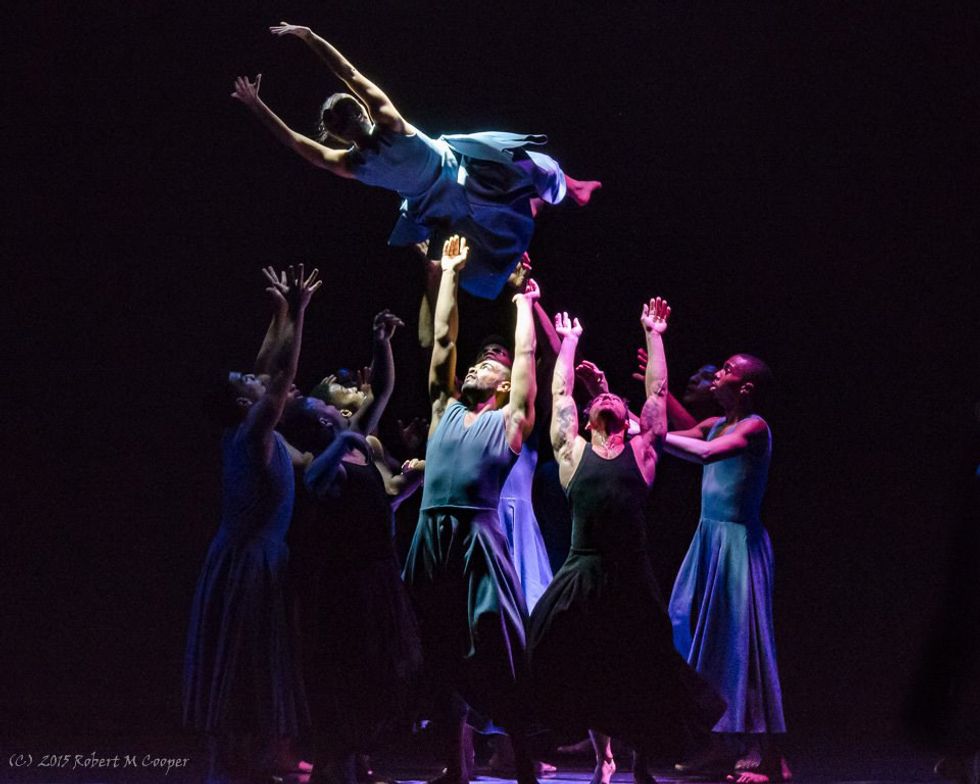Take to heart your negative critics and you will always be their prisoner. The very moment you can visualize being free from the things that hold you back—your comfort zone—you have indeed begun to set yourself open. For both casts of choreographer Frederick Earl Mosley’s twenty-five dancers, this was further put into action in his work entitled “Wild and Free.”
Composed of music selections from NY Drums and Len Faki, the dancers are first witnessed grooving to a sound score of their own choreographical choosing. In this initial mark, the audience is left to question what is to come as after two counts of eights displayed there is an immediate split between staging feeding into set structures and phrasing material. This is the first example of many where the theme of freedom is encountered.
Much like a forest bird never wants a cage, neither do humans. But what would happen if society did not follow a direct path of stabilization and grounding? It is without doubt that in order to survive in an environment some standards must be applied and followed. In this piece the work shows a clear depiction of what it means to live and function no less in a world built within a cage. Humans are not animals in the sense that they are forever trapped, however the free spirit is awakened in due part to this confinement into such strict ways.
Constructed by creatures, and though not bounded, it is wherever one goes. No matter where one runs, it is a run into one’s self. What is wild about this phenomenon then you may ask? The heart. It is the dancer or individual within a group that still gets as nervous before every performance as she did for her first. The day that her nerves settle and are unaffected by a show or performance is the day she loses her distinctiveness. Being nervous means a person cares about the outcome and is still pushing to be a better version of herself.
Feeling nothing, means a dancer has settled in her confident mundane place, lacking the idea of embracing the nerves and simply letting go. There is no taxation on the thoughts of being or following one’s instincts which is why this choreographic dance is captivating for it replicates a wanderer within a set pack. Ideally it is those who belong to no one, yet everyone. Although unspecified, Mosley’s vision plays with the roles of bringing out art yet giving order to the chaos of humanity- all of which is observed within a ten-minute framework.
Within each section there is a constant focus on detail and uniformity, but what differs is the “free spirit” or soloists within each phrasing. Have you ever read a sentence where there is one discreet word that stands out to you, perhaps in bold but often emphasizing more meaning to the context? This is that moment. To describe this piece is like explaining an oxymoron for in order to be “free” one must be willing to forego the norm and display acceptable risks.
To put it into a visual perspective, what you are about to see is a body of dancers dressed in similar attire and form, but not of exact coloring. While most are represented in black, others are fitted in a baby blue or teal format. Essentially all colors will agree in the dark; however, regardless of the outfit the ones who spark are those who have the colorful, liberated mind and the movements generated from these that enlighten the piece and bring out the characters. After all, a broken crayon will still color much like the individualist who breaks his ritual will still succeed. Let it be known that it took every ounce of courage and energy for these wanderers to display confidence at a time when their largest fear carried their greatest growth.
This was the reaction during the rehearsal duration. The process in learning the material was a quick one. The choreographer never once began a minute past the clock and the dancers were forced into an intense- both physical and intellectual- learning environment. The first few weeks of preparation were spent picking up the style and memorizing sensations and qualities. Dancers were often told to feel “grounded” and “fully-embodied” into the piece as if it were a type of expression to one’s own life.
The rhythms were heard in the music selections, but the effect would decrease if they were missing from within the soul as well. One’s heartbeat became the most played song as if it were a dual act worn as a blessing in the chest like a second heart. Like the creatures we are, we do not make progress unless we stick out our necks. So come let the motion set you free.






 Photo by
Photo by 














